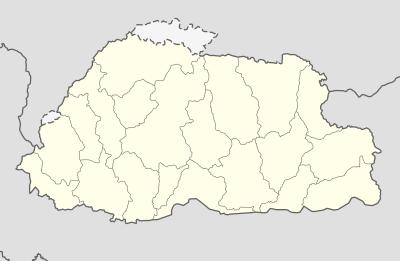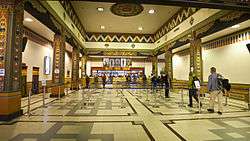Paro Airport
Paro International Airport (Dzongkha: སྤ་རོ་གནམ་ཐང༌ paro gnam thang) (IATA: PBH, ICAO: VQPR) is the sole international airport of the four airports in Bhutan. It is 6 km (3.7 mi; 3.2 nmi) from Paro in a deep valley on the bank of the river Paro Chhu. With surrounding peaks as high as 5,500 m (18,000 ft), it is considered one of the world's most challenging airports,[2] and less than two dozen pilots are certified to land at the airport.[3][4]
Paro Airport སྤ་རོ་གནམ་ཐང༌། | |||||||||||
|---|---|---|---|---|---|---|---|---|---|---|---|
.jpg) | |||||||||||
| Summary | |||||||||||
| Airport type | Public | ||||||||||
| Operator | Department of Civil Aviation | ||||||||||
| Serves | Thimphu and Paro District | ||||||||||
| Location | Paro District | ||||||||||
| Hub for | |||||||||||
| Elevation AMSL | 2,235 m / 7,332 ft | ||||||||||
| Coordinates | 27°24′32″N 089°25′14″E | ||||||||||
| Map | |||||||||||
 PBH Location within Bhutan | |||||||||||
| Runways | |||||||||||
| |||||||||||
Flights to and from Paro are allowed under visual meteorological conditions only and are restricted to daylight hours from sunrise to sunset.[5] Paro airport was the only airport in Bhutan until 2011.[6] Paro Airport is accessible by road, 6 km (3.7 mi; 3.2 nmi) from Paro city, and 54 km (34 mi; 29 nmi) from Thimphu by Paro-Thimphu road.
History

In 1968, the Indian Border Roads Organisation built an airstrip in the Paro valley, which was initially used for on-call helicopter operations by the Indian Armed Forces on behalf of the Royal Government of Bhutan. Bhutan's first airline, Drukair, was established by Royal Charter on 5 April 1981.
Paro Airport is deep in a valley 2,235 m (7,332 ft) above mean sea level and is surrounded by mountains as high as 5,500 m (18,000 ft).[7] The airport was constructed with a runway 1,200 m (3,900 ft) in length,[8] giving the Bhutanese government specific requirements for a choice of aircraft to be operated from Paro. They required an 18–20 seat STOL-capable aircraft with operating capabilities which included a high service ceiling, high rate of climb and high manoeuvrability. The major requirement for the aircraft was that it must be capable of flying Kolkata – Paro – Kolkata, a 1,200 km (750 mi; 650 nmi) round-trip, without refuelling, due to minimal infrastructure being available at Paro. Three aircraft types were considered after flight tests that had been conducted in India and Bhutan between 1978 and 1980; however, none was deemed suitable.[8]
In mid-1981, the Indian government set up a committee to study its own requirements for a light transport aircraft. Based upon this study, the Bhutanese government ordered one Dornier 228-200 for delivery in January 1983, with the option for a second aircraft for delivery in late 1983. The first 18-seat Dornier 228-200 landed at Paro Airport on 14 January 1983. The exact time of landing, the number of passengers on board and even the direction the aircraft was parked on the airport apron being predetermined by the high lama of Paro Dzong.[8]
Drukair inaugurated scheduled revenue flights from Paro on 11 February 1983, with Flight 101 departing Paro for Kolkata and returning the next day as Flight 102. At the time of service commencement, Paro Airport consisted of the runway, a two-room air traffic control building (with the ground floor acting as the check-in counter) and a departure lounge on the lawn.[9] Before the establishment of the Department of Civil Aviation in January 1986, Drukair was responsible for the operation and maintenance of the airport's infrastructure.[10]
In 1990, the runway at Paro Airport was lengthened from 1,402 to 1,964 m (4,600 to 6,445 ft) and reinforced for heavier aircraft.[11][12] A hangar was constructed for the aircraft, which was funded by the Indian government as part of the Paro Airport Development Project.[13]
On 21 November 1988, Drukair's first jet, a BAe 146-100, was delivered to Paro Airport. In 2003, Drukair was seeking a replacement for the BAe 146 and on 19 October 2004 the airline's first Airbus A319-100 arrived in Paro.[14]
Buddha Air became the first international airline to operate charters to Paro in August 2010.[15] Tashi Air, Bhutan's first private airline, was started in December 2011.[16] In 2012, it was reported that 181,659 passengers used the airport.[17] By 2018, this number had grown to 397,599 and 6,761 flights were handled by the airport. A new parallel taxiway was constructed allowing the airport to handle up to 50 flights a day.[18]
Facilities
The airport has a single 1,964 m (6,445 ft) asphalt runway,[1] and there is one terminal building that was commissioned in 1999.[19]
Airlines and destinations
| Airlines | Destinations |
|---|---|
| Bhutan Airlines | Bangkok–Suvarnabhumi, Delhi, Kathmandu, Kolkata |
| Druk Air | Bagdogra, Bangkok–Suvarnabhumi, Delhi, Dhaka, Dubai–International (begins 4 September 2020), Gaya, Gelephu, Guwahati, Jakar, Kathmandu, Kolkata, Mumbai, Singapore, Tokyo–Narita (begins 2 September 2020), Trashigang |
References
- "Paro – Vqpr". World Aero Data. Retrieved 29 December 2012.
- Cruz, Magaly; Wilson, James; Nelson, Buzz (July 2003). "737-700 Technical Demonstration Flights in Bhutan" (PDF). Aero Magazine (3): 1, 2. Retrieved 12 February 2011.CS1 maint: multiple names: authors list (link)
- Ahlgren, Linnea. "Why So Few Pilots Are Allowed At Bhutan's Paro Airport". Simple FLying. Retrieved 6 April 2020.
- Farhad Heydari (October 2009). "The World's Scariest Runways". Travel & Leisure. Retrieved 12 February 2011.
- "Paro Bhutan". Air Transport Intelligence. Reed Business Information. 2011. Archived from the original on 7 August 2011. Retrieved 12 February 2011.
- "History |". Archived from the original on 23 November 2016.
- "The A319 excels in operations from high-altitude airports" (Press release). Airbus. 8 February 2005. Archived from the original on 13 December 2014. Retrieved 15 June 2014.
- Christ, Rolf F. (June 1983). "Bhutan puts its flag on the world's air map". ICAO Journal. 38 (6): 11–13. Archived from the original on 4 January 2017. Retrieved 15 June 2014.
- Chattopadhyay, Suhrid Sankar (9 May 2008). "Aiming high". Frontline. 25 (9): 122. ISSN 0970-1710. Archived from the original on 10 January 2016. Retrieved 15 June 2014.
- "Department of Civil Aviation". Ministry of Information and Communication (Bhutan). Archived from the original on 6 July 2011. Retrieved 25 April 2010.
- "On the Wings of a Dragon: 25 Years of Progress" (PDF). Tashi Delek. XIII (3): 76. July–September 2008. Retrieved 25 April 2010.
- Brunet, Sandra; Bauer, Johannes; De Lacy, Terry; Tshering, Karma (2001). "Tourism Development in Bhutan: Tensions between Tradition and Modernity". Journal of Sustainable Tourism. 9 (3): 243. CiteSeerX 10.1.1.120.6843. doi:10.1080/09669580108667401.
- Zimba, Dasho Yeshey (1996). "Bhutan Towards Modernization". In Ramakant and Misra, Ramesh Chandra (ed.). Bhutan: Society and Polity (2nd ed.). Indus Publishing. p. 144. ISBN 978-81-7387-044-6. Retrieved 30 July 2008.
- "Drukair's first Airbus lands in Paro". Paro: Kuensel. 20 October 2004. Archived from the original on 10 June 2011. Retrieved 26 April 2010.
- Buddha Air in service Archived 15 April 2012 at the Wayback Machine Bhutan Broadcasting Service, 24 August 2010.
- "Tashi Group - TASHI AIR LAUNCHED ON 4TH DEC. 2011". tashigroup.bt. Archived from the original on 5 November 2012. Retrieved 12 December 2014.
- "Running short of space and human resource". KuenselOnline. Archived from the original on 13 December 2014. Retrieved 12 December 2014.
- "DoAT to revamp Paro international airport in the 12th Plan". KuenselOnline. Retrieved 13 May 2019.
- "Paro Airport". dca.gov.bt. Archived from the original on 2 December 2011. Retrieved 12 December 2014.
External links
![]()
- BBC World feature on landing at Paro Airport
- Airport information for VQPR at World Aero Data. Data current as of October 2006.